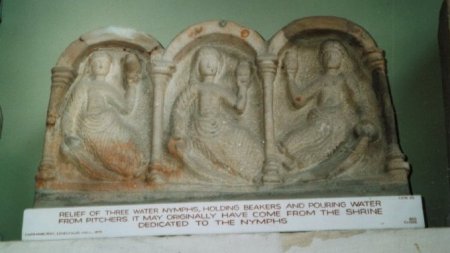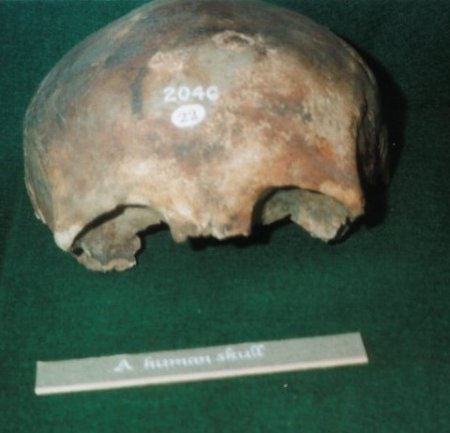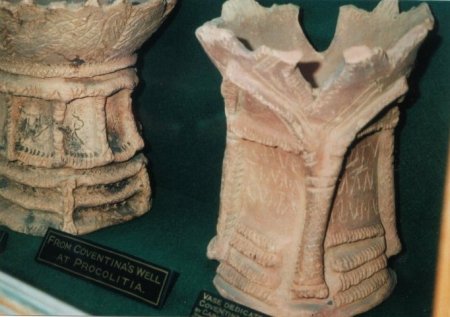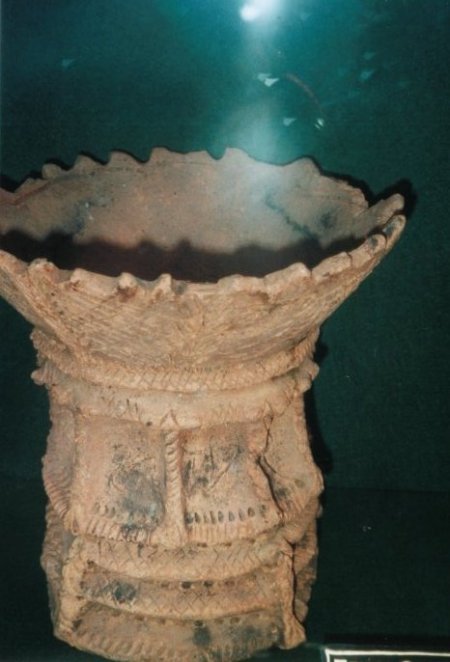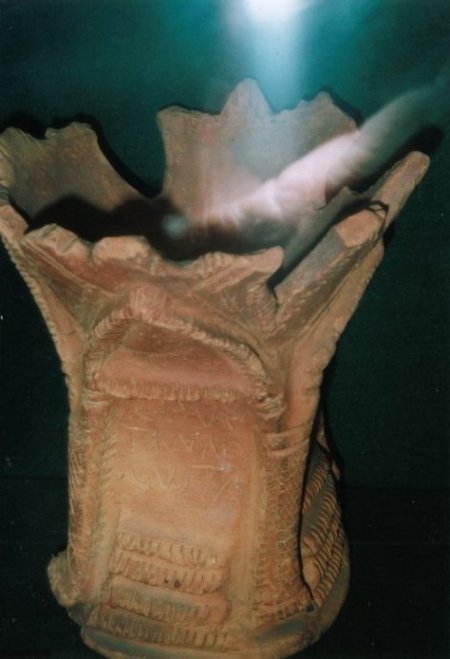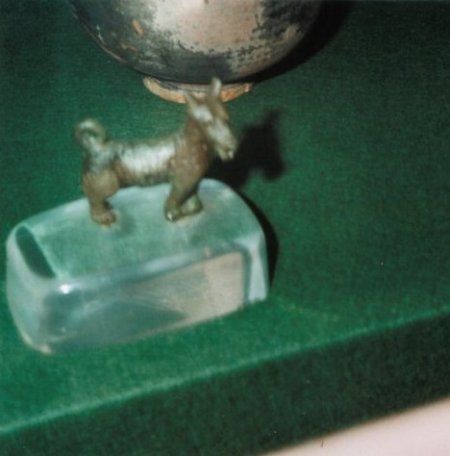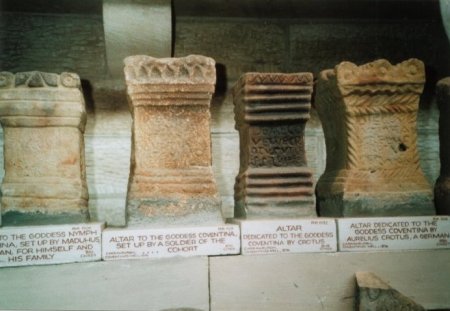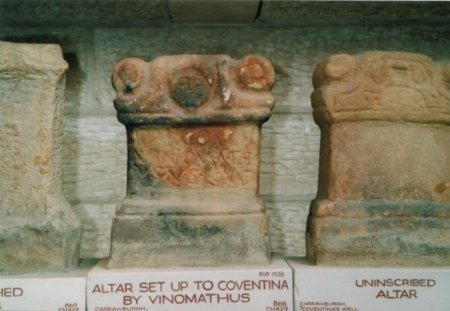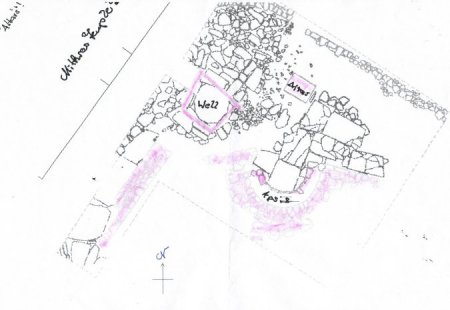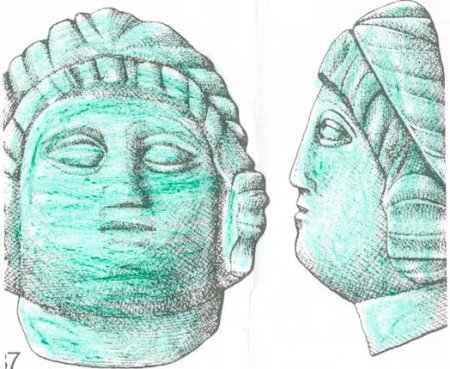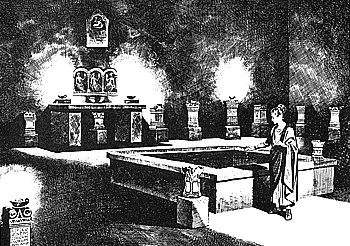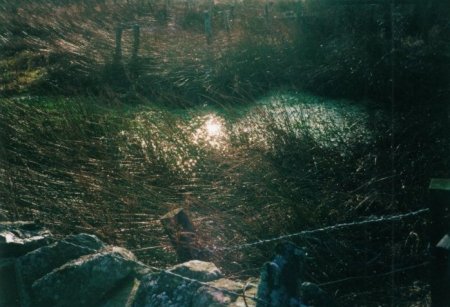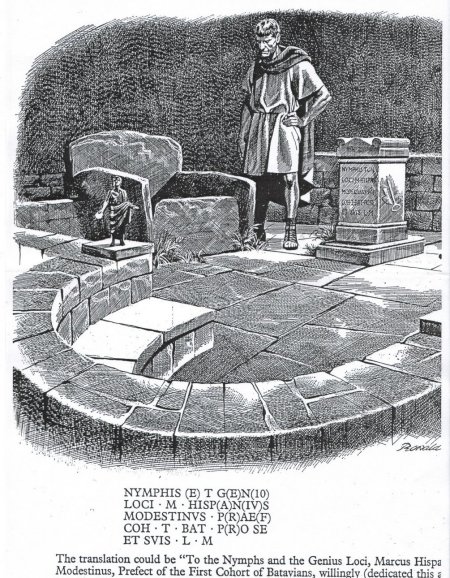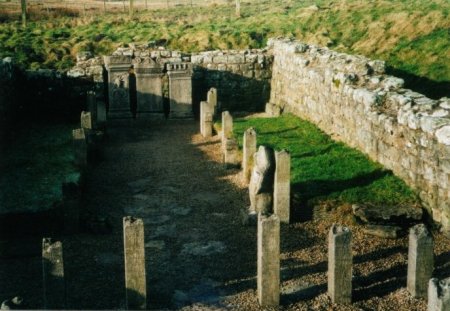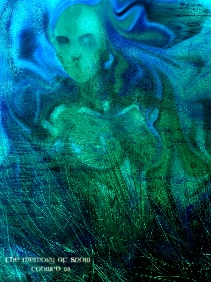Images
- Ancient images of Coventina
- Remains of Coventina's temple
- The neighbouring temples
- Archaeological finds
- Photographs of the landscape
- Maps and photographs of the site
- Modern images of Coventina
Special thanks to Jurgen and Alistair, who very kindly contributed most of these photographs!


Ancient art

This is a Romano-Celtic stone carving retrieved from the well. It shows Coventina reclining on a large leaf and holding another. As you can see, the inscription spells her name Covventina.
A stone carving. Opinions about this piece vary. Some people think that this carving shows Coventina, but shows her in triplicate. Three was a sacred number to the Celts as it was to many ancient peoples, and as it is to Christians today. So possibly the sculptor carved Coventina tripled, as he or she may have believed this repetition increased the power of the image. Many goddesses are shown in three forms, namely Maiden, Mother, and Crone. But in this carving, the three ladies all seem to be of similar age. Other people think this shows Coventina with two attendants. Still others think that this is not anything to do with Coventina but instead a survival from the nearby Nymphaeum (a small temple dedicated to three nymphs, or female spirits) that was stashed in Coventina's well for safekeeping when all the temples on the site were closed. But note that the three ladies are all in the act of pouring water. Personally I lean towards thinking this is a carving of Coventina in triplicate.

A carving in oak, possibly of Coventina. This image was sent to me by Stanley Bruce of Banffshire Maritime & Heritage Society in Aberdeenshire in Scotland. The carving is believed to have come from Banff monastery, which was established by King Robert the Bruce in 1321, and which was destroyed by an arsonist in 1559, although some walls still stood until the 1800s. The carving definitely dates from pre-1559, perhaps to mediaeval times. Back then there were many wells in the town and perhaps the monastery had its own well with this image on it -- we'll never know. The carving is on display in Banff Museum.


Finds
This damaged and incomplete skull was found in the well. Some people think that this is a relic of human sacrifice at the temple, but since the skull isn't whole and no other human remains were found there or nearby, this is very unlikely. The Celts did have religious traditions that involved taking the heads of their enemies and displaying them, usually near entranceways. But archaeologists think that the skull was placed in the well much later than the other finds, which makes it unlikely to be Celtic. The Romans, while they had little respect for human life, were firmly against human sacrifice for religious purposes. So perhaps the skull was found elsewhere and 'reburied' respectfully at a sacred site.
Lots of incense burners were found in the well.
Incense burning seems to have been a big part of worship at the temple, and at many temples at the time. Incense then wasn't the thin sticks or cones we use today, but instead grains of aromatic resin (often, dried tree sap) burnt on charcoal. Some cultures believe that prayer rises to the divine with the smoke. Whether that's true or not, the sweet smell makes everyone who breathes it breathe more deeply, thus relaxing them and putting them in the right frame of mind for worship -- religious aromatherapy! These incense burners, made of inflammable clay and having a bowl shaped top, were perfectly suited to this use.
Some of the incense burners were inscribed, like the altars, with Coventina's name and a dedication.
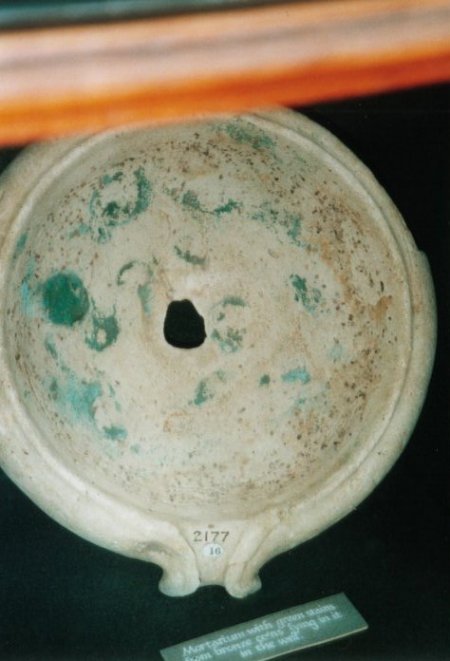
This mortarium (a Roman mixing vessel with a gritted inner surface and a pouring spout) was probably used for grinding mixtures of incense. It has stains from the bronze coins lying in it in the water for so long. Thousands of coins, offerings to the goddess, were found in the well. They help archaeologists date the activity at the site.

This pottery vessel has a face carved into it that looks very like the face from the altars, so it is probably intended to represent the goddess. It may have been used to pour libations (offerings of wine). It still retains some of its painted decoration.
A bronze statuette of an animal. Smaller versions of an item were often offered to the divine in place of an offering of the real thing. Sometimes a votive offering like this was not a sacrifice but a form of request, perhaps for increased prosperity.

A view of the museum interior, showing just some of the finds.
A row of altars from Coventina's temple. Note the elaborate carvings and the inscriptions. Each one is different. Altars in those days were not the communal table-like structures that we are used to seeing. Instead they were more like individual platforms, or workbenches, that the worshipper would stand or kneel beside and make offerings on. The top of the altar usually featured a round shallow depression that could hold the offering. Click the picture to enlarge.
Another row of altars from Coventina's temple. Click the picture to enlarge.


The landscape

View of Procolitia Roman Fort, looking North. © Alistair.

Looking North, Mithras Temple at bottom of picture, moon in top corner. © Alistair.

Looking over Procolitia fort, facing South-West. © Alistair.

The site
Aerial photograph of the site.
Map of the site. Click the picture to enlarge.
This plan of the temples on the site shows how the other temples are laid out very close to Coventina's well, forming a sacred precinct beside the Roman fort. Click the picture to enlarge.
Artist's reconstruction of the 'face of Coventina'.


Remains of Coventina's temple
An artist's impression of what Coventina's temple may have looked like, showing the low wall around the well's basin in the centre. Click the picture to enlarge.
All that remains in situ of Coventina's temple today -- an oblong granite basin, still in place to collect the water from the spring. Click the picture to enlarge.
Spring water.
The well surrounded by drifts of wildflowers. Click the picture to enlarge.
Close up of the wildflowers.

View from the temple site, looking east towards the earthwork remains of the fort.


The neighbouring temples
An artist's impression of what the Nymphaeum (a temple to the Nymphs sited beside Coventina's temple) may have looked like.
The third temple on the site was a Mithraeum (temple of Mithras). Click the picture to enlarge. Mithras was a Persian (Iranian) god whose worship spread throughout the Roman Empire. His worship was very popular with the soldiers of the Roman army. In fact, his fame eclipsed that of Christ at one time. He was worshipped exclusively by men and in secret rites, so not much is known about Mithraism.
We do know from the mosaics and sculptures that remain at this and other sites, that his myth involved the slaying of a bull by a young man, the blood from the bull's wounds falling to the earth where flowers spring up. The bull is believed to represent the forces of evil, the young man is believed to represent the forces of good, and the bull's blood fertilising the vegetation is believed to linked with fertility and renewal.
In this photograph, you can see the layout of the well-preserved Mithraeum, which has a central aisle bordered by pillars, leading up to a line of altars.


Coventina in contemporary art
This evocative modern image of Coventina, called The Memory of Snow, is © Cobweb 2008. Click to enlarge.
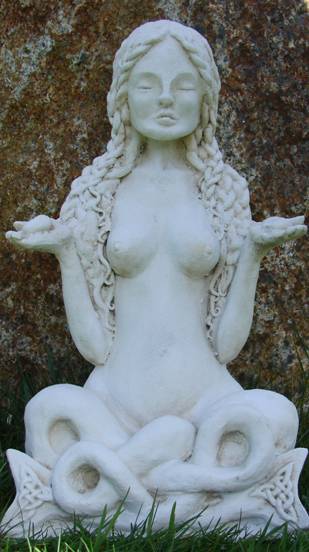
This sculpture is one of several goddess images made by Sonjia Tremain, who is based in Cornwall. This image is © Stone Circle Sculpture 2007.
This modern image of "The Goddess of the North" is part of a regeneration project called Northumberlandia. I'm told the project was called Coventina before some local religious groups protested that the name smacked of paganism. This image is © H J Banks Developments 2006. Click to enlarge.

This image is © Boudicca's Bard 2006

This image is © Jonathon Earl Bowser 2006. This isn't actually anything to do with Coventina according to the artist, but it seemed appropriate to me. A rose by any other name, and all that.
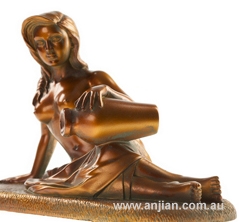
This sculpture of Coventina is one of a selection of sacred images from Anjian Australia 2007. (Thanks to Annie for the link!)


The Story of Coventina · The Seventh City upon the Wall · Coventina in Context · Fact & Folklore
Images · Archaeological Site · Spirituality
Other Goddess Sites · Fanlisting · Contact · Home

Graphics © FMG · Valid XHTML & CSS · Pro standards & access
All original content © Tehomet 2005




